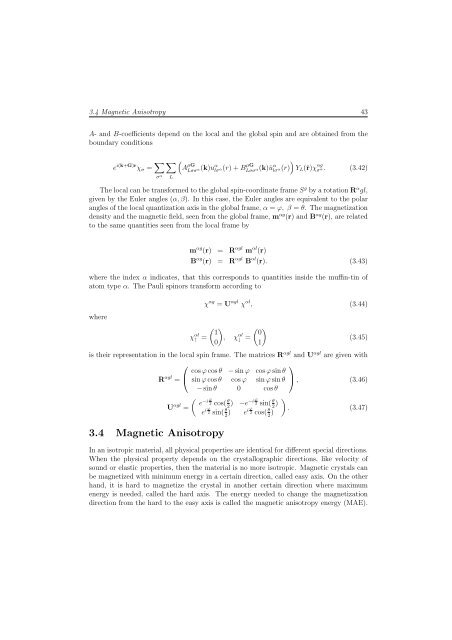Ab initio investigations of magnetic properties of ultrathin transition ...
Ab initio investigations of magnetic properties of ultrathin transition ...
Ab initio investigations of magnetic properties of ultrathin transition ...
You also want an ePaper? Increase the reach of your titles
YUMPU automatically turns print PDFs into web optimized ePapers that Google loves.
3.4 Magnetic Anisotropy 43<br />
A- and B-coefficients depend on the local and the global spin and are obtained from the<br />
boundary conditions<br />
e i(k+G)r χσ = � � �<br />
A μG<br />
Lσσα(k)uαlσα(r)+BμG Lσσα(k)˙uα lσα(r) �<br />
YL(ˆr)χ αg<br />
σα. (3.42)<br />
σ α<br />
L<br />
The local can be transformed to the global spin-coordinate frame S g by a rotation R α gl,<br />
given by the Euler angles (α, β). In this case, the Euler angles are equivalent to the polar<br />
angles <strong>of</strong> the local quantization axis in the global frame, α = ϕ, β = θ. The magnetization<br />
density and the <strong>magnetic</strong> field, seen from the global frame, m αg (r) and B αg (r), are related<br />
to the same quantities seen from the local frame by<br />
m αg (r) = R αgl m αl (r)<br />
B αg (r) = R αgl B αl (r). (3.43)<br />
where the index α indicates, that this corresponds to quantities inside the muffin-tin <strong>of</strong><br />
atom type α. The Pauli spinors transform according to<br />
where<br />
χ αl<br />
↑ =<br />
χ αg = U αgl χ αl , (3.44)<br />
� �<br />
1<br />
, χ<br />
0<br />
αl<br />
↓ =<br />
� �<br />
0<br />
1<br />
(3.45)<br />
is their representation in the local spin frame. The matrices R αgl and U αgl are given with<br />
⎛<br />
cos ϕ cos θ − sin ϕ cos ϕ sin θ<br />
sin ϕ cos θ cos ϕ sin ϕ sin θ<br />
R αgl = ⎝<br />
− sin θ 0 cos θ<br />
U αgl �<br />
−i e<br />
=<br />
ϕ<br />
2 cos( θ)<br />
2<br />
ϕ<br />
−e−i 2 sin( θ<br />
2 )<br />
ϕ<br />
i e 2 sin( θ<br />
3.4 Magnetic Anisotropy<br />
2<br />
) ei ϕ<br />
2 cos( θ<br />
2 )<br />
⎞<br />
⎠ , (3.46)<br />
�<br />
. (3.47)<br />
In an isotropic material, all physical <strong>properties</strong> are identical for different special directions.<br />
When the physical property depends on the crystallographic directions, like velocity <strong>of</strong><br />
sound or elastic <strong>properties</strong>, then the material is no more isotropic. Magnetic crystals can<br />
be magnetized with minimum energy in a certain direction, called easy axis. On the other<br />
hand, it is hard to magnetize the crystal in another certain direction where maximum<br />
energy is needed, called the hard axis. The energy needed to change the magnetization<br />
direction from the hard to the easy axis is called the <strong>magnetic</strong> anisotropy energy (MAE).

















